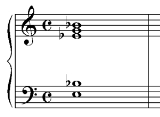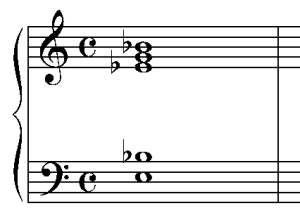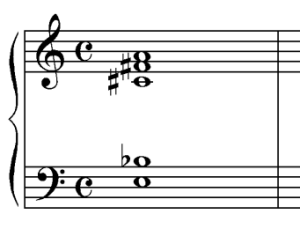
Upper structure
Encyclopedia
In jazz music, the term upper structure or upper structure triad refers to a voicing
approach developed by jazz pianists and arrangers
defined by the sounding of a major or minor
triad
in the uppermost pitches
of a more complex harmony
.
In the lower-stave the notes E and B are given. These form a tritone which defines the dominant sound, and are the major 3rd and flattened 7th of the C79 chord.
In the upper-stave the notes E (enharmonic
ally equivalent to D), G, and B are given together: these form an E major triad.
 This E major triad is what would be called the upper structure. Considered in relation to the root C, the notes of this E major triad function, respectively, as the sharpened ninth, fifth, and seventh in relation to that root.
This E major triad is what would be called the upper structure. Considered in relation to the root C, the notes of this E major triad function, respectively, as the sharpened ninth, fifth, and seventh in relation to that root.
(Note: the root C is omitted here, and is often done so by jazz pianists for ease of playing, or because a bass player is present.)
Example 2: The following example illustrates the notes of an F minor triad functioning as part of a C13911 chord (C major chord with a flat 7th, flatted ninth, sharpened 11th, and 13th):
 In relation to the root of C, the C (enharmonic
In relation to the root of C, the C (enharmonic
with D) functions as a flattened ninth, the F-sharp functions as a sharpened eleventh, and the A functions as the thirteenth.
The chord C13911 contains the following notes, from the root upwards: C, E, G, B, D, F, A
The following octatonic scale
contains all of these pitches, and fits or matches up with the C13911 chord:
C, D, E, F, G, A, B, C
Choosing from the available pitches given by this octatonic scale, we can construct a number of major, and minor triads: C major [CEG], G major [G(F)-B-D], F minor [F-A-D(C)], A major [A-D(C)-E], and A minor [A-C-E].
Juxtaposing any of these triads over the original C13911 chord will provide a potential upper structure that agrees with this chord type and the related scale.
Example two (C13911) is called upper structure sharp minor four, and can be written shorthand as USiv.
Other possible upper structures are:
USII - e.g. D major over C7, resulting in C1311 9
USV - e.g. G major over C7, resulting in C7911
USVI - e.g. A major over C7, resulting in C7913
USVI - e.g. A major over C7, resulting in C139
USi - e.g. C minor over C7, resulting in C79
USii - e.g. D minor over C7, resulting in C79 13
USiii - e.g. E minor over C7, resulting in C7911
', from Miles Davis's Kind of Blue.
Voicing (music)
In music composition and arranging, a voicing is the instrumentation and vertical spacing and ordering of the pitches in a chord...
approach developed by jazz pianists and arrangers
Arrangement
The American Federation of Musicians defines arranging as "the art of preparing and adapting an already written composition for presentation in other than its original form. An arrangement may include reharmonization, paraphrasing, and/or development of a composition, so that it fully represents...
defined by the sounding of a major or minor
Major and minor
In Western music, the adjectives major and minor can describe a musical composition, movement, section, scale, key, chord, or interval.Major and minor are frequently referred to in the titles of classical compositions, especially in reference to the key of a piece.-Intervals and chords:With regard...
triad
Triad (music)
In music and music theory, a triad is a three-note chord that can be stacked in thirds. Its members, when actually stacked in thirds, from lowest pitched tone to highest, are called:* the Root...
in the uppermost pitches
Pitch (music)
Pitch is an auditory perceptual property that allows the ordering of sounds on a frequency-related scale.Pitches are compared as "higher" and "lower" in the sense associated with musical melodies,...
of a more complex harmony
Harmony
In music, harmony is the use of simultaneous pitches , or chords. The study of harmony involves chords and their construction and chord progressions and the principles of connection that govern them. Harmony is often said to refer to the "vertical" aspect of music, as distinguished from melodic...
.
Examples
Example 1: Below, a common voicing used by jazz pianists is given for the chord C79 (C major chord with a flat 7th, and extended with a sharpened 9th).In the lower-stave the notes E and B are given. These form a tritone which defines the dominant sound, and are the major 3rd and flattened 7th of the C79 chord.
In the upper-stave the notes E (enharmonic
Enharmonic
In modern musical notation and tuning, an enharmonic equivalent is a note , interval , or key signature which is equivalent to some other note, interval, or key signature, but "spelled", or named, differently...
ally equivalent to D), G, and B are given together: these form an E major triad.

(Note: the root C is omitted here, and is often done so by jazz pianists for ease of playing, or because a bass player is present.)
Example 2: The following example illustrates the notes of an F minor triad functioning as part of a C13911 chord (C major chord with a flat 7th, flatted ninth, sharpened 11th, and 13th):

Enharmonic
In modern musical notation and tuning, an enharmonic equivalent is a note , interval , or key signature which is equivalent to some other note, interval, or key signature, but "spelled", or named, differently...
with D) functions as a flattened ninth, the F-sharp functions as a sharpened eleventh, and the A functions as the thirteenth.
Application
Determining which upper structure(s) can be juxtaposed on top of a chord is achieved by considering the relationship between a particular chord and the scale it implies. An example follows:The chord C13911 contains the following notes, from the root upwards: C, E, G, B, D, F, A
The following octatonic scale
Octatonic scale
An octatonic scale is any eight-note musical scale. Among the most famous of these is a scale in which the notes ascend in alternating intervals of a whole step and a half step, creating a symmetric scale...
contains all of these pitches, and fits or matches up with the C13911 chord:
C, D, E, F, G, A, B, C
Choosing from the available pitches given by this octatonic scale, we can construct a number of major, and minor triads: C major [CEG], G major [G(F)-B-D], F minor [F-A-D(C)], A major [A-D(C)-E], and A minor [A-C-E].
Juxtaposing any of these triads over the original C13911 chord will provide a potential upper structure that agrees with this chord type and the related scale.
Shorthand notation
Common jazz parlance refers to upper structures by way of the interval between the root of the bottom chord and the root of the triad juxtaposed above it. For instance, in example one above (C79) the triad of E-flat major is a (compound) minor 3rd away from C (root of the bottom chord). Thus, this upper structure can be called upper structure flat three, or USIII for short.Example two (C13911) is called upper structure sharp minor four, and can be written shorthand as USiv.
Other possible upper structures are:
USII - e.g. D major over C7, resulting in C1311 9
USV - e.g. G major over C7, resulting in C7911
USVI - e.g. A major over C7, resulting in C7913
USVI - e.g. A major over C7, resulting in C139
USi - e.g. C minor over C7, resulting in C79
USii - e.g. D minor over C7, resulting in C79 13
USiii - e.g. E minor over C7, resulting in C7911
Recordings
A quintessential example of a pianist using upper structures is Bill Evans's playing on 'Blue in GreenBlue in Green
"Blue in Green" is the third track on Miles Davis' 1959 album, Kind of Blue. One of two ballads on the LP , "Blue in Green"'s melody is very modal, incorporating the presence of the dorian, mixolydian, and lydian modes...
', from Miles Davis's Kind of Blue.
See also
- Extended harmony
- Jazz chord
- Jazz scaleJazz scaleA jazz scale is any musical scale used in jazz. Many "jazz scales" are common scales drawn from Western European classical music, including the diatonic, whole-tone, octatonic , and the modes of the ascending melodic minor...
s - Octatonic scaleOctatonic scaleAn octatonic scale is any eight-note musical scale. Among the most famous of these is a scale in which the notes ascend in alternating intervals of a whole step and a half step, creating a symmetric scale...
- Polychord

